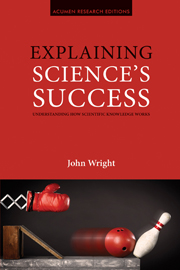Book contents
- Frontmatter
- Contents
- 1 Some surprising phenomena
- 2 Some unsatisfactory explanations of the phenomena
- 3 A defeasible a priori justification of induction
- 4 The independence of theory from data
- 5 Some more success-conducive properties of theories
- 6 Newton's laws of motion and law of gravitation
- 7 Special relativity
- 8 Mendelian genetics
- 9 Conclusion
- Notes
- Bibliography
- Index
9 - Conclusion
- Frontmatter
- Contents
- 1 Some surprising phenomena
- 2 Some unsatisfactory explanations of the phenomena
- 3 A defeasible a priori justification of induction
- 4 The independence of theory from data
- 5 Some more success-conducive properties of theories
- 6 Newton's laws of motion and law of gravitation
- 7 Special relativity
- 8 Mendelian genetics
- 9 Conclusion
- Notes
- Bibliography
- Index
Summary
We have now completed our explanations of the three phenomena given at the start of this book. In chapter 2 we laid down four criteria of adequacy that must be met by any such explanation. Let us now determine the extent to which the explanations offered here meet these four criteria.
THE FIRST CRITERION
A satisfactory explanation must explain how we have managed to hit upon successful theories
In chapter 2 we noted two corollaries of this first criterion. The first corollary was the accessibility requirement that any property M of theories used to explain the forms of success must be more accessible that the forms of success it explains. The second corollary was the explicability requirement that any satisfactory explanation must explain why we have preferred theories with M rather than any one of the other highly accessible properties of theories.
Most of the work in explaining the phenomena has been done by the notions of the independence of theory from data and intra-DEC independence. In some cases we also explained the success of a theory by appealing to the fact that it used a low whole number, or that it was supported by the AIM inference. Plainly, all of these features of theories meet the accessibility requirement. A theory is independent of the data if it has a high ratio of components of data explained to dependent explanatory components of theory. As we have already observed, this is an easily accessible feature of a theory.
- Type
- Chapter
- Information
- Explaining Science's SuccessUnderstanding How Scientific Knowledge Works, pp. 175 - 186Publisher: Acumen PublishingPrint publication year: 2012



